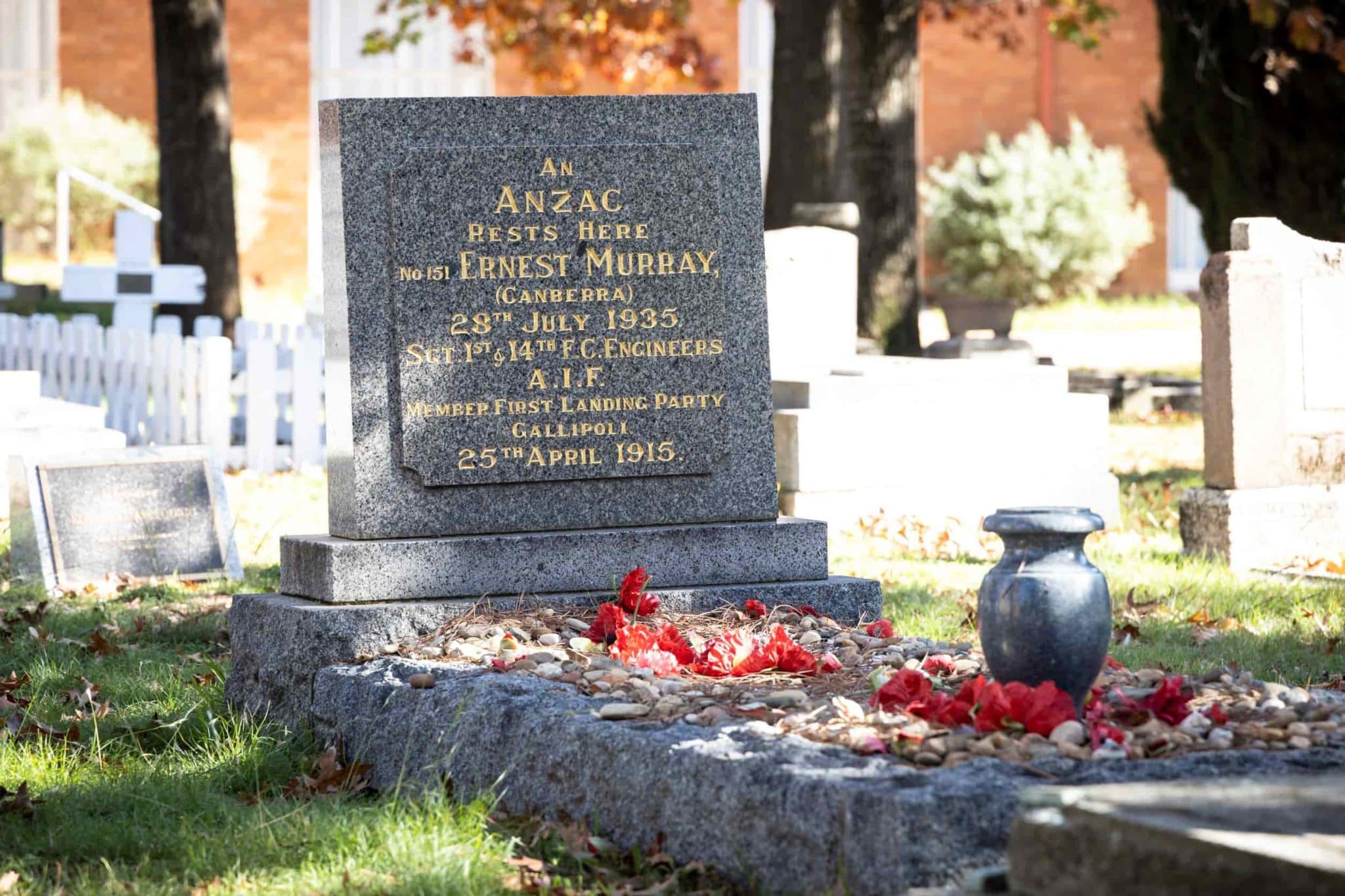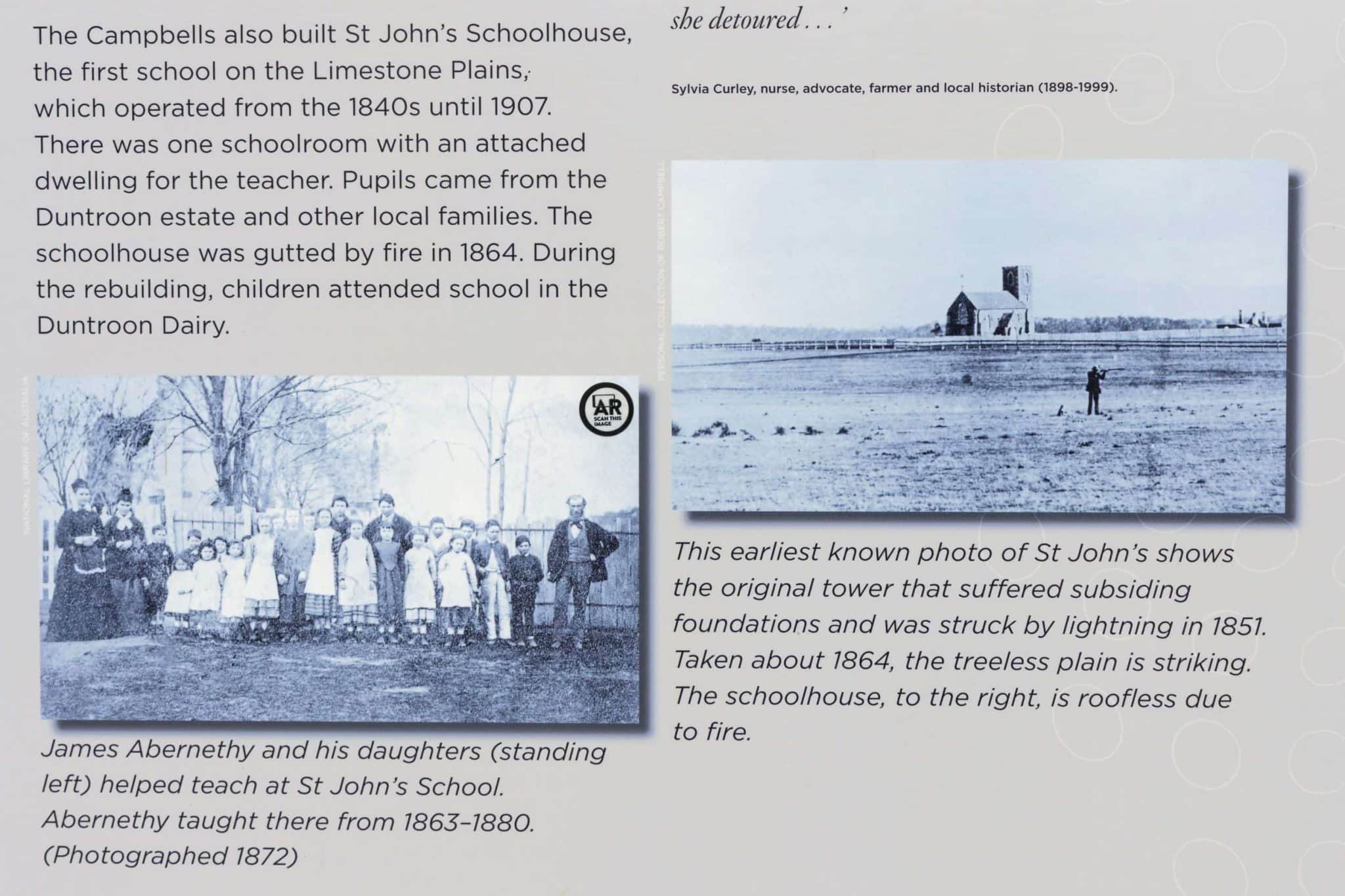Local resident Neil Bowman shares what you might find on a stroll around historic St John’s Anglican Church (1841) in Reid, ahead of the church’s community fair on Saturday 15 October.
I am standing in front of the grave of Ernest Murray in the small, picturesque churchyard cemetery of the Anglican church of St John the Baptist Canberra in Reid.
The headstone simply states ‘An Anzac Rests Here’.

Who was he? It states ‘Member First Landing Party Gallipoli 25th April 1915’ but I can’t help but wonder what his hopes and dreams as a young man were, other than returning home in one piece from Gallipoli and the Somme. His daughter, Margaret Magi (who was possibly Canberra’s longest living resident before moving to Brisbane earlier this year) said “anyone who knew him said he was a good bloke”.
- Is Margaret Magi, 95, our longest residing Canberran? (18 February 2022)
I look around this peaceful and beautiful place, an English village church, which, through a quirk of history, had our nation’s capital literally built around it.
Another grave, dated 8 November 1845, introduces me to Sarah Webb, who tragically died during childbirth. Her headstone reads, ‘For here we have no continuing city but seek one to come,’ a biblical quote referring to a heavenly city hoped for by believers. Remarkably, only a few decades after Sarah’s death, the Limestone Plains were earmarked as the site of the future national capital, and the quote was taken by many as a coincidental prophecy of the coming city of Canberra.
I ponder the lives of others buried here.
The commanding memorial to Viscount Dunrossil, the only Governor-General to die in office is quite different to the nearby vault of Elizabeth Guise. She was born in – goodness me – 1762! Of all the burials here, she was the earliest to have arrived in Australia. I wonder if she ever imagined as a teenager that one day, she would set sail in the Second Fleet (or maybe Third) and live in a remote rural community on the other side of the world?
I pass by the impressive obelisk to honour the wonderfully-named past Rector of St John – Pierce Galliard Smith (PG Smith to his friends?) who faithfully laboured here for 50 years starting in 1855. According to the records, he officiated at 248 funerals. I would have loved to have heard his views on the meaning of life. And sadly, infant and childhood mortality were a frequent occurrence for Canberra’s early settlers, and this churchyard contains several such poignant statues.
However, this precinct contains many other visual insights into the almost 180 years of European history of the Limestone Plains and the developing capital.
I love the famous photo of the church taken in 1864 standing in stark relief to the flat sheep pastures.


Now this National Trust listed building remains a modest, though still striking example of Gothic Revival architecture and is still the focal point for a local Anglican community.
Inside the church are many beautiful stained-glass windows, including two small windows in the South porch remarkably made from fragments of glass collected on the Somme battlefield during WWI! Above the pulpit is an icon of the church’s namesake, St John the Baptist, and I learn that it is thought to have been painted in a Cypriot monastery in the 16th or 17th century. Laid up at the western end of the Church, near the entry door, are the Regimental Colours presented by Queen Elizabeth II to the Royal Military College (RMC) Duntroon in 1954, a reflection of St John’s close connection with RMC.
The RMC Colours have an interesting history in that they were made for King George VI to present. When he died, they had to have Queen Elizabeth II’s emblem stitched on. The stitching is still clear on the Colours.
Outside the church is the original schoolhouse, the first on the Limestone Plains, that operated as far back as 1845. It is now restored as a museum that is open to visitors.
Wandering past the fountain on the lawn, I come across the ‘horse paddock’ bordered by Himalayan Cypress hedges planted almost a century ago. Who could guess that this is so close to the CBD? Yet it contains 12 different native grasses and is home to the endangered Golden Sun Moth.
Space doesn’t allow me to describe other gems in the churchyard but I did discover the meaning of a ‘lychgate’ and a ‘glebe’ (as in Glebe Park). More graves to visit are the resting place of our most recently deceased Governor-General, Major General The Honourable Michael Jeffery, and the memorial to Flying Officer Francis Ewen, whose plane crashed during the fly-past at the opening of Parliament House in 1927.
To see these, and hear a far more informed commentary, you can join guided heritage tours at the St John’s Community Fair on Saturday 15 October between 9am and 2.30pm, at 45 Constitution Avenue, Reid. The tours of the Church and the grounds will be conducted by Duntroon Guides. This is a wonderful opportunity for Canberra’s old and young to enjoy this remarkable historical precinct in the city, soaking up the atmosphere of an English style village fair.
- Neil Bowman
Canberra Daily is keen to hear from you about a story idea in the Canberra and surrounding region. Click here to submit a news tip.



